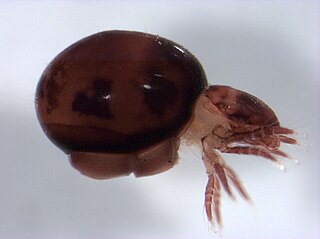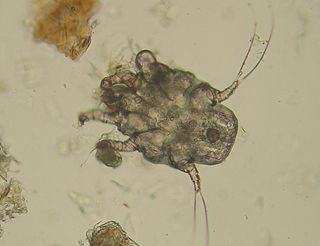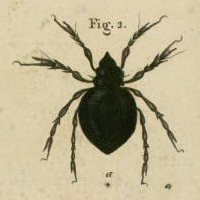
Mites are small arachnids. Mites span two large orders of arachnids, the Acariformes and the Parasitiformes, which were historically grouped together in the subclass Acari, but genetic analysis does not show clear evidence of a close relationship.

The Acariformes, also known as the Actinotrichida, are the most diverse of the two superorders of mites. Over 32,000 described species are found in 351 families, with an estimated total of 440,000 to 929,000 species, including undescribed species.

Oribatida, also known as oribatid mites, moss mites or beetle mites, are an order of mites, in the "chewing Acariformes" clade Sarcoptiformes. They range in size from 0.2 to 1.4 millimetres. There are currently 12,000 species that have been identified, but researchers estimate that there may be anywhere from 60,000 to 120,000 total species. Oribatid mites are by far the most prevalent of all arthropods in forest soils, and are essential for breaking down organic detritus and distributing fungi.

Astigmatina is a clade of mites in the superorder Acariformes. Astigmata has been ranked as an order or suborder in the past, but was lowered to the unranked clade Astigmatina of the clade Desmonomatides in the order Sarcoptiformes. Astigmatina is now made up of the two groups Acaridia and Psoroptidia, which have been suborders of the order Astigmata in the past. Astigmatina contains about 10 superfamilies and 76 families under Acaridia and Psoroptidia.
Hoplophthiracarus is a genus of mites in the family Steganacaridae.
Austrophthiracarus is a genus of mites in the family Steganacaridae.
Pneumolaelaps is a genus of mites in the family Laelapidae.
Galumna pseudokhoii is a species of mite first found in Cát Tiên National Park, Vietnam, in dark loam in a Lagerstroemia forest. This species is very similar in the location and morphology of notogastral areae porosae, rostral morphology, lamellar and interlamellar setae, lamellar lines locations, and incomplete dorsosejugal suture to Galumna khoii, differing in body size, sensilli morphology, and the number of genital setae on the anterior parts of its genital plates.
Pergalumna indistincta is a species of mite first found in Cát Tiên National Park, Vietnam, in dark loam in a Lagerstroemia forest. This species is similar in notogastral areae porosae, punctate body surfaces, prodorsal setae morphology, and dorsosejugal suture, to Pergalumna amorpha, differing in body size and the development of its adanal setae.
Galumna levisensilla is a species of mite first found in sandy soil in a dipterocarp forest of Cát Tiên National Park.
Neogalumna seniczaki is a species of mite first found in sandy soil in a dipterocarp forest of Cát Tiên National Park.

Belba is a genus of mites belonging to family Damaeidae. The genus was established by Carl von Heyden in 1826. Notaspis corynopus was the type species. Species that are part of the genus can be found in Eurasia and North America.
Neophyllobius is a genus of mites.
Plateremaeidae is a family of oribatids in the order Sarcoptiformes. There are about 7 genera and 19 described species in Plateremaeidae.

Phthiracaridae is a family of oribatid mites in the order Oribatida. There are about 7 genera and at least 710 described species in Phthiracaridae.
Phenopelopidae is a family of oribatid mites in the order Sarcoptiformes. As of 2018, there were 4 genera and 106 species known in this family.

Enarthronota is a suborder of mites in the order Oribatida. There are about 14 families and more than 450 described species in Enarthronota.

Oripodoidea is a superfamily of oribatids in the order Oribatida. There are about 19 families and at least 1,300 described species in Oripodoidea.
Magdalena Kathrina Petronella Smith Meyer was a South African acarologist who was regarded as a world authority on plant-feeding mites of agricultural importance and was known as the "mother of red-spider mites of the world". She described more than 700 new species and 25 new genera, mostly of mites of agricultural importance. Meyer was involved in the promotion of biological control of mites using predatory mites, spiders and insects.

Galumna is a genus of mites in the family Galumnidae.







